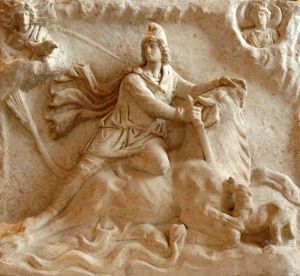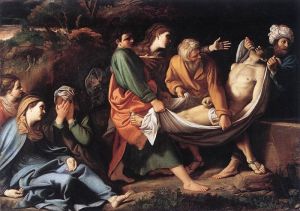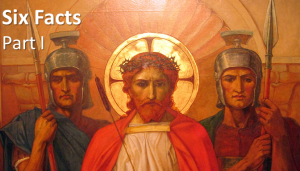A popular argument used by some to discredit Christianity is that the story of Jesus is simply a compilation or retelling of earlier “god man” or “dying and rising god” myths taken from pagan religions at the time. People making this argument typically offer a long and very compelling list of similarities that seem to make their case unassailable. To someone who has never heard this argument, or its counters, it can sound convincing that Christianity is just a fairy tale that is copied from other fairy tales. Continue reading
About That Error-Filled New Testament…

The Codex Sinaiticus, a handwritten Greek manuscript written in the middle of the fourth century. It is the earliest existing complete copy of the New Testament.
“Don’t you know that the New Testament is full of errors? Over the years, scribes made copy after copy, and introduced so many alterations, errors, and variations that today we can’t even be sure what the original texts said! In fact, scholars have shown that the surviving manuscripts have around 400,000 variations. That’s a horrible number, especially considering that the entire New Testament only has about 138,000 words!” Continue reading
The Truth About Jesus’ Burial
One assertion made by anti-Christian authors, such as Bart Ehrman in his recent book, How Jesus Became God, is that Jesus was never buried in a tomb. Contrary to gospel accounts, they say, the Roman authorities did not allow executed criminals to be buried. Instead, Jesus would have been left hanging on the cross to become carrion for birds and dogs. There was no “empty tomb” from which the resurrected Jesus could have emerged because, simply put, there was no tomb. Continue reading
Lies They’ll Tell You
We should all be grateful for thoughtful criticism of the New Testament because it forces us to truly study the texts, think about their origins, assess their accuracy, and understand their historical backdrop. In recent years, however, various anti-Christian professors and authors (Richard Dawkins, Bart Ehrman, and the late Christopher Hitchens are just three examples) have written books attempting to tear down the Christian faith and cast doubt on the New Testament’s validity. Continue reading
If God Is So Great, Then Why Is the World So Screwed Up?
 Why is there so much suffering in this world? If God really exists, why do bad things happen to good people? This is one of the most significant questions asked by both atheists and believers. This single question has caused millions to deny the existence of God or ultimately reject the God in which they once believed.
Why is there so much suffering in this world? If God really exists, why do bad things happen to good people? This is one of the most significant questions asked by both atheists and believers. This single question has caused millions to deny the existence of God or ultimately reject the God in which they once believed.
Six Facts About Jesus – Part III
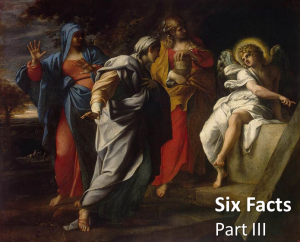 In The Case for the Resurrection of Jesus, Gary R. Habermas, Ph.D. and Michael R. Licona, Ph.D. lay out five facts about Jesus that are basically beyond dispute. These facts are nearly universally accepted by scholars, both Christian and skeptic. To those facts, I have added one of my own (#1 below). These facts are strongly attested historically, and they do not rely on the Bible being divinely inspired or even reliable to be accepted: Continue reading
In The Case for the Resurrection of Jesus, Gary R. Habermas, Ph.D. and Michael R. Licona, Ph.D. lay out five facts about Jesus that are basically beyond dispute. These facts are nearly universally accepted by scholars, both Christian and skeptic. To those facts, I have added one of my own (#1 below). These facts are strongly attested historically, and they do not rely on the Bible being divinely inspired or even reliable to be accepted: Continue reading
Six Facts About Jesus – Part II
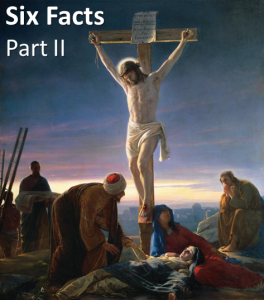 In The Case for the Resurrection of Jesus, Gary R. Habermas, Ph.D. and Michael R. Licona, Ph.D. lay out five facts about Jesus that are basically beyond dispute.
In The Case for the Resurrection of Jesus, Gary R. Habermas, Ph.D. and Michael R. Licona, Ph.D. lay out five facts about Jesus that are basically beyond dispute.
These facts are nearly universally accepted by scholars, both Christian and skeptic. To those facts, I have added one of my own (#1 below). These facts are strongly attested historically, and they do not rely on the Bible being divinely inspired or even reliable to be accepted: Continue reading
Six Facts About Jesus – Part I
In a book that I highly recommend, The Case for the Resurrection of Jesus, Gary R. Habermas, Ph.D. and Michael R. Licona, Ph.D. lay out five facts about Jesus that are basically beyond dispute. These facts are nearly universally accepted by scholars, both Christian and skeptic. They are strongly attested historically, and they do not rely on the Bible being divinely inspired or even reliable to be accepted. Let’s take a look at those five facts, and while we’re at it, I’ll add one of my own: Continue reading
Christianity 101
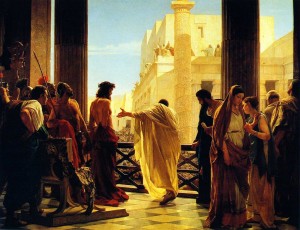
Antonio Ciseri’s depiction of Pontius Pilate presenting a scourged Christ to the people: Ecce homo! (Behold the man!). Painted 1871.
Christianity, in its broadest sense, is the world’s largest religion with over two billion followers. However, because of the many denominations and varying beliefs and traditions, the term can be confusing and often means different things to different people.
So, especially for those who are newly exploring the faith, it’s important to answer the question: “At its core, what is Christianity all about?” Continue reading
Do Greek Gospels Mean Weak Gospels?
 In a recent post, we explored the origins of the gospels. These books outlining Jesus’ life, ministry, death, and resurrection, were written relatively soon after his crucifixion and, evidence indicates, are basically first- and second-hand accounts. The gospels of Matthew and John were written by two of Jesus’ original disciples, at least according to tradition and to early church historians.
In a recent post, we explored the origins of the gospels. These books outlining Jesus’ life, ministry, death, and resurrection, were written relatively soon after his crucifixion and, evidence indicates, are basically first- and second-hand accounts. The gospels of Matthew and John were written by two of Jesus’ original disciples, at least according to tradition and to early church historians.
Recently, while on a trip across the country, I was reading a book that repeated a common argument against the gospels being eyewitness accounts. Continue reading

